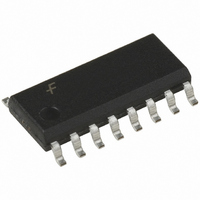74LVX163MX Fairchild Semiconductor, 74LVX163MX Datasheet - Page 2

74LVX163MX
Manufacturer Part Number
74LVX163MX
Description
IC COUNTER BINARY SYNC 16SOIC
Manufacturer
Fairchild Semiconductor
Series
74LVXr
Datasheet
1.74LVX163M.pdf
(9 pages)
Specifications of 74LVX163MX
Logic Type
Binary Counter
Direction
Up
Number Of Elements
1
Number Of Bits Per Element
4
Reset
Synchronous
Timing
Synchronous
Count Rate
115MHz
Trigger Type
Positive Edge
Voltage - Supply
2 V ~ 3.6 V
Operating Temperature
-40°C ~ 85°C
Mounting Type
Surface Mount
Package / Case
16-SOIC (3.9mm Width)
Lead Free Status / RoHS Status
Lead free / RoHS Compliant
www.fairchildsemi.com
Functional Description
The LVX163 counts in modulo-16 binary sequence. From
state 15 (HHHH) it increments to state 0 (LLLL). The clock
inputs of all flip-flops are driven in parallel through a clock
buffer. Thus all changes of the Q outputs occur as a result
of, and synchronous with, the LOW-to-HIGH transition of
the CP input signal. The circuits have four fundamental
modes of operation, in order of precedence: synchronous
reset, parallel load, count-up and hold. Four control
inputs—Synchronous Reset (MR), Parallel Enable (PE),
Count Enable Parallel (CEP) and Count Enable Trickle
(CET)—determine the mode of operation, as shown in the
Mode Select Table. A LOW signal on MR overrides count-
ing and parallel loading and allows all outputs to go LOW
on the next rising edge of CP. A LOW signal on PE over-
rides counting and allows information on the Parallel Data
(P
edge of CP. With PE and MR HIGH, CEP and CET permit
counting when both are HIGH. Conversely, a LOW signal
on either CEP or CET inhibits counting.
The LVX163 uses D-type edge-triggered flip-flops and
changing the MR, PE, CEP and CET inputs when the CP is
in either state does not cause errors, provided that the rec-
ommended setup and hold times, with respect to the rising
edge of CP, are observed.
The Terminal Count (TC) output is HIGH when CET is
HIGH and counter is in state 15. To implement synchro-
nous multistage counters, the TC outputs can be used with
the CEP and CET inputs in two different ways.
Figure 1 shows the connections for simple ripple carry, in
which the clock period must be longer than the CP to TC
delay of the first stage, plus the cumulative CET to TC
delays of the intermediate stages, plus the CET to CP
setup time of the last stage. This total delay plus setup time
sets the upper limit on clock frequency. For faster clock
rates, the carry lookahead connections shown in Figure 2
n
) inputs to be loaded into the flip-flops on the next rising
2
are recommended. In this scheme the ripple delay through
the intermediate stages commences with the same clock
that causes the first stage to tick over from max to min in
the Up mode, or min to max in the Down mode, to start its
final cycle. Since this final cycle takes 16 clocks to com-
plete, there is plenty of time for the ripple to progress
through the intermediate stages. The critical timing that lim-
its the clock period is the CP to TC delay of the first stage
plus the CEP to CP setup time of the last stage. The TC
output is subject to decoding spikes due to internal race
conditions and is therefore not recommended for use as a
clock or asynchronous reset for flip-flops, registers or
counters. When the Parallel Enable (PE) is LOW, the paral-
lel data outputs O
outputs. A HIGH signal on PE forces O
impedance state but does not prevent counting, loading or
resetting.
Logic Equations: Count Enable
H
L
X
MR
LOW Voltage Level
HIGH Voltage Level
Immaterial
H
H
H
H
L
LOW-to-HIGH Clock Transition
PE
X
H
H
H
L
CET
0
–O
X
X
H
X
L
Mode Select Table
3
are active and follow the flip-flop Q
CEP
X
X
H
X
L
TC
Reset (Clear)
Load (P
Count (Increment)
No Change (Hold)
No Change (Hold)
CEP • CET • PE
Q
Action on the Rising
0
• Q
Clock Edge (
1
n
0
• Q
–O
2
3
Q
• Q
to the High
n
)
3
• CET
)
















